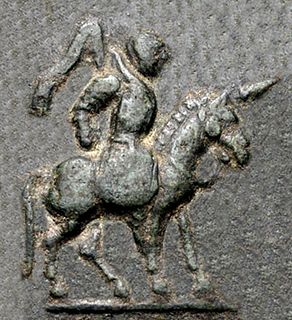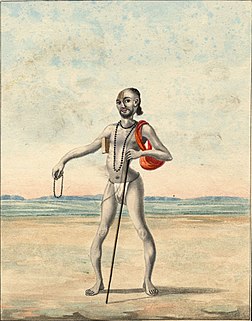
Bharadwaja, also referred to as Bharadvaja or Bharadvaja Bṛhaspatya, was one of the revered Vedic sages (rishi) in Ancient India, who was a renowned scholar, economist and an eminent physician. His contributions to the ancient Indian literature, mainly in Puranas and Rig Veda, played a significant role in giving an insight to the then Indian society. He and his family of students are considered the authors of the sixth book of the Rigveda. Bharadwaja was father of warrior Brahmin Droṇācārya, a main character in Mahabharata who was an instructor to both Pandava and Kaurava princes. He was grandfather of Aśvatthāma, a legendary warrior in Mahabharata. Both Droncharya and Ashwatthama fought in different battles of Mahabharata alongside Kauravas. Bharadwaja is also mentioned in Charaka Samhita, an authoritative ancient Indian medical text. Maharishi Bharadwaj is considered as the "Father of Medicine" (Ayurveda)

The word Yona in Pali and the Prakrits, and the analogue "Yavana" in Sanskrit, are words used in Ancient India to designate Greek speakers. "Yona" and "Yavana" are transliterations of the Greek word for "Ionians", who were probably the first Greeks to be known in the East.

Maues was the first recorded Indo-Scythian king. He invaded India and established Saka hegemony by conquering Indo-Greek territories.

Ashtavakra is a revered Vedic sage in Hinduism. His name literally means "eight bends", reflecting the eight physical handicaps he was born with. His maternal grandfather was the Vedic sage Aruni, his parents were both Vedic students at Aruni's school. Ashtavakra studied, became a sage and a celebrated character of the Hindu History(Itihas) Epics and Puranas.
The Rishikas are a possibly-mythical tribe of Central Asia and South Asia, who are mentioned in Hindu and Sanskrit literary texts, including the Mahabharata, the Ramayana, the Brhat-Samhita, the Markendeya Purana and Patanjali's Mahabhasya.

The Shaka era is a historical calendar era, corresponding to Julian year 78. It is commonly known in Indian languages as Shalivahana Śaka or RTGS: Mahasakkarat "Greater Era").

The Saptarishi are the seven rishis in ancient India, who are extolled at many places in the Vedas and Jivan literature. The Vedic Samhitas never enumerate these rishis by name, though later Vedic texts such as the Brahmanas and Upanisads do so. They are regarded in the Vedas as the patriarchs of the Vedic religion.
The Chinas or Chīnaḥ are a people mentioned in ancient Indian literature from the first millennium BC, such as the Mahabharata, Laws of Manu, as well the Puranic literature.
The kingdom of Tushara according to Ancient Indian literature, such as the epic Mahabharata was a land located beyond north-west India. In the Mahabharata, its inhabitants, known as the Tusharas, are depicted as mlechchas ("barbarians") and fierce warriors.
Daradas were a people who lived north to the Kashmir valley. Their kingdom is identified to be the Gilgit region in Kashmir along the river Sindhu or Indus. They are often spoken along with the Kambojas. The Pandava hero Arjuna had visited this country of Daradas during his northern military campaign to collect tribute for Yudhishthira's Rajasuya sacrifice.
Hunas were a tribe close to Himalayas that, because of limited interaction with Indian kingdoms, were mentioned in the epic Mahabharata. They belonged to the Xinjiang province of China, east of Jammu-Kashmir. However, they were nomadic people who changed their settlements from time to time.
Nishada is the name of a tribe mentioned in ancient Indian literature. The ancient texts mention several kingdoms ruled by this tribe. In the Mahabharata, Nishadas mentioned as tribes that have the hills and the forests their abode. They are linked with a king called Vena who became a slave of wrath and malice, and became unrighteous. Brahmanas slew him. Some of Vena's descendants became Nishadas and some others were called Mlechchhas, who resided on the Vindhya mountains (12,58).
The Pahlavas are a people mentioned in ancient Indian texts like the Manu Smriti, various Puranas, the Ramayana, the Mahabharata, and the Brhatsamhita. In some texts the Pahlavas are also mentioned as "Pallavas": While the Vayu Purana distinguishes between Pahlava and Pahnava, the Vamana Purana and Matsya Purana refer to both as Pallava. The Brahmanda Purana and Markendeya Purana refer to both as Pahlava or Pallava. Bhishama Parava Mahabharata 6.11.66 of the Mahabharata also does not distinguish between the Pahlavas and Pallavas. The Pahlavas are said to be same as the Parasikas. According to P. Carnegy, the Pahlava are probably those people who spoke Paluvi or Pehlvi, that is the Parthian language. Buhler similarly suggests Pahlava is an Indic form of Parthava meaning 'Parthian'. In the 4th century BCE, Vartika of Katyayana mentions the Sakah-Parthavah demonstrating an awareness of these Saka-Parthians, probably by way of commerce.
The Bahlikas were the inhabitants of Balikha, mentioned in Atharvaveda, Mahabharata, Ramayana, Puranas, Vartikka of Katyayana, Brhatsamhita, Amarkosha etc. and in the ancient Inscriptions. The other variations of Bahlika are Bahli, Balhika, Vahlika, Valhika, Bahlava, Bahlam/Bahlim, Bahlayana and Bahluva.

Komedes is the ethnonym of a people in Central Asia during antiquity, who were mentioned by the ancient Greek geographer Ptolemy, in his Geography. Ptolemy reported that the Komedes were found throughout the "entire mountainous land of the Sacae", including Bactria, Sogdiana and/or Transoxiana.

The legacy of the Indo-Greeks starts with the formal end of the Indo-Greek Kingdom from the 1st century CE, as the Greek communities of central Asia and northwestern India lived under the control of the Kushan branch of the Yuezhi, apart from a short-lived invasion of the Indo-Parthian Kingdom. The Kushans founded the Kushan Empire, which was to prosper for several centuries. In the south, the Greeks were under the rule of the Western Kshatrapas.

Central Asia and Ancient India have long traditions of social-cultural, religious, political and economic contact since remote antiquity. The two regions have common and contiguous borders, climatic continuity, similar geographical features and geo-cultural affinity. For millennia, there has been an uninterrupted flow of people, material and the ideas between the two.















